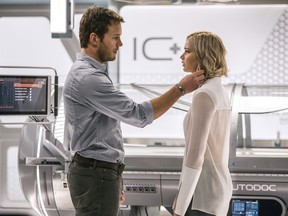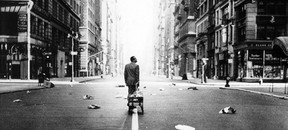The Night Is Short Walk on Girl Art Wrong Anatomy
Why the movies and cinematic altitude help convey isolation better than any other art form
Chris Knight: To watch a movie alone – critics know this sensation well – is to be at once lone and in the visitor of others; to share communion with ghosts

Reviews and recommendations are unbiased and products are independently selected. Postmedia may earn an affiliate commission from purchases fabricated through links on this page.
"The Concluding Man! Yes I may well describe that solitary existence'south feelings, feeling myself as the last relic of a love race, my companions extinct before me."
Mary Shelley wrote that in her journal in May of 1824, shortly earlier embarking on her novel The Last Human. Less well received than Frankenstein, less remembered today, it nonetheless finds another powerful intersection of imagination and science in the story of a small, dwindling group of survivors of a late 21st-century plague.
Shelley wasn't the first to imagine the predicament of the sole survivor – Le Dernier Homme, published past Jean-Baptiste Cousin de Grainville in 1805, gives us a far future in which humans are becoming sterile, as in the 1992 novel and 2006 film Children of Men.
Neither work did well; critics of the fourth dimension seemed horrified past the very idea of extinction. Although by 1936 the philosopher and critic Walter Benjamin, writing virtually talking pictures, noted: "(Flesh'southward) cocky-alienation has reached such a degree that it tin experience its ain destruction as an aesthetic pleasure of the outset order."
Movies are where final-man (and they are almost always men) narratives found fertile ground. There is something central in united states that thrills to the vision and the notion of being the final survivor – though we tend to ignore the fact that if 7.4 billion humans were to vanish or perish, odds are we'd be among them.

We can't help but identify ourselves in the survivor'south shoes. The distancing effect of movie theatre lets u.s.a. appreciate the oddness of the experience – like chasing a spy through the streets of Tangier, say, or spending a day with Tom Cruise – fifty-fifty though we know the actual event would exist utterly terrifying.
This desire for the incident is why the trailer for 1959's The World, the Mankind and the Devil promises "the story that puts YOU in the picture," and breathlessly asks: "What would You lot exercise if yous were one of the last three people on Earth?"
Certainly the notion of scarcity would vanish in a world full of consumer goods and only one consumer; and almost every last-human being story includes a shopping spree and at least one expensive automobile. In the motion-picture show Passengers, which finds Chris Pratt and Jennifer Lawrence alone on a vast spaceship, she looks at his clothes and remarks: "You went shopping." He replies: "I went shoplifting."
And bid farewell to pollution. In I Am Fable, when the last human being in New York takes a deep, satisfying breath of air ane morning, we realize that afterwards a few years of ambulation out, Manhattan would scent like the Hamptons. And if Hell is other people, and then surely there is Sky in their absence.
Such narratives also let u.s. explore our existential fears as a species. Shelley, writing a century later Daniel Defoe'southward A Journal of the Plague Year, used contagion as her murderous MacGuffin. Where Have All the People Gone, from 1974, suggests solar flares. In The Noah (1975), On the Beach (1959) and many others, it's a nuclear ending.

Often the survivors are beset past zombies, as in The Last Homo on Earth (1964, with Vincent Price), remade every bit The Omega Human being (1971, Charlton Heston) and I Am Fable (2007, Will Smith). Or 1985's Night of the Comet, an unusual example in that it features a comic tone and female person protagonists.
Then there are the tales in which the last human comes upon a woman and another man; drama at its most Aristotelian! A stunning example of this form is the 1985 New Zealand film The Quiet Earth, in which scientist Zac Hobson spends weeks (and about 40 minutes of screen fourth dimension) thinking he'southward the simply one left later a ability-grid experiment goes awry. He and so meets Joanne and Api, the resultant love triangle made more astute by the fact that Api is Maori and the other two white.
The Quiet World was recently re-released on Bluray with a commentary from astrophysicist Neil deGrasse Tyson, who unfortunately says too little virtually the science in the film, and zero about its beautiful, bewildering final shot. But information technology holds a special place in my centre. Not only is it a great movie, but I saw it while playing hooky with a friend from loftier school – a midweek matinee about the last people on Earth, watched by an audience of ii.
This is perhaps what makes cinema the ideal grade for stories about the end of the world and its final survivors. Unlike dance, concerts or theatre, cinema (and its pocket-size-screen offshoots) offers the appearance of a live performance with no other human actually present. To watch a movie alone – critics know this sensation well – is to be at one time solitary and in the company of others; to share communion with ghosts.

The ephemeral nature of movies adds another weird layer of loneliness; sometimes the performers are non only absent-minded but deceased too. Of the iii survivors in The World, the Flesh and the Devil, only one of the actors – 89-twelvemonth-sometime Harry Belafonte – is still alive.
Of form, there are very few true last-homo-alive movies. The 2000 comedy The Last Man and TV's The Final Man on World would seem to promise as much, but the dear triangle (or quadrilateral, or pentagon …) proves as well tempting for screenwriters. For stories of single protagonists, nosotros must commonly await to tales in which someone has been cast adrift from the residual of humanity and must struggle to return.
The noon of this conceit is surely Robert Redford in the cheerily named All Is Lost (2013). A solitary sailor, listed in the credits but every bit "our human being," has his boat damaged by a rogue shipping container floating in the Indian Ocean. He spends the rest of the moving picture, alone and almost wordless, trying to save himself. In like straits, and in guild of proximity, are Tom Hanks in Cast Away (on an island), Sandra Bullock in Gravity (in orbit), Sam Rockwell in Moon (the moon) Matt Damon in The Martian (Mars) and Chris Pratt – for a while, at least – in Passengers (interstellar space).
It'southward a twice tricky feat. At that place's the filmmaking challenge of constructing and shooting a narrative with no sentient antagonist. For the actor comes the endeavor of working solo; the reaction from other players that so often fuels a great performance is missing. Simply when done well, these stripped-down narratives are downright thrilling to behold.
-
Is there even a distinction to be made anymore between tv set and movies?
-
Why practise nosotros continue to be held captive past Goggle box that is no longer satisfying?
No word of the movie theater of loneliness would be consummate without the film that features not three humans, or ii, only none. In 2008's WALL-E, the first, perfect 15 minutes of story are about a cocky-enlightened trash-collecting robot and his cockroach friend on a deserted, garbage-strewn Earth. Information technology's not until the half-hour mark that nosotros run across any humans – and even and then, they remain largely secondary to the plot.
I like to think that, in Passengers, as Pratt pines for companionship on the starship Avalon, and is eventually rewarded with Jennifer Lawrence (lucky couple!) that somewhere, light-years behind them, some other terminal-beingness-standing tale is playing out on the Earth they left behind. Science-fiction has given united states of america fantastic battles and noisy adventures, but its lasting legacy might simply be solitude.
Source: https://nationalpost.com/entertainment/movies/last-man-stories-and-cinema-that-stands-alone

0 Response to "The Night Is Short Walk on Girl Art Wrong Anatomy"
Enviar um comentário